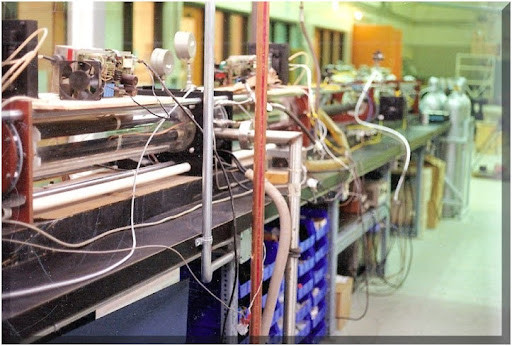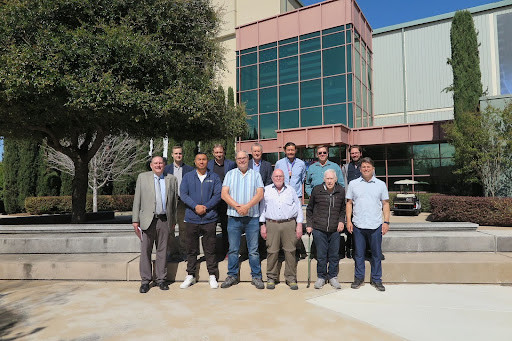
Nuclear power has long been a whisper in the alternative energy conversation. While many experts consider it a viable successor to fossil fuels, one problem has historically gotten in the way: a lack of scalability. Now, U.S.-based LIS Technologies is finally developing a process to manufacture nuclear fuel on a commercial basis. As a result, the dream of large-scale nuclear power just might become a reality.
It's the culmination of the life's work of two luminaries in the field of nuclear energy, Dr. Jeff Eerkens (often regarded as the Father of Laser Enrichment) and laser enrichment scientist Christo Liebenberg. The journey began with Eerkens's development of the CRISLA (Condensation Repression Isotope Selective Laser Activation) process of uranium enrichment in the late 1980s and early 1990s.
Uranium enrichment is the process of taking natural uranium and increasing the concentration of U-235, the isotope needed to create fuel for nuclear reactors. Natural uranium is about 0.7% U-235.
The current fleet of lightwater reactors (LWRs) run on low-enriched uranium (LEU), which is up to 5% U-235. The new generation of small, highly efficient advanced reactors typically requires high-assay low-enriched uranium (HALEU), which is up to 20% U-235.
Research in CRISLA's development stopped when the U.S. started purchasing its nuclear fuel from Russia. "They funded this technology back in the '90s," says Jay Yu, LIS Technologies Chairman and President. "They scrapped it because the Iron Curtain fell, and Russia flooded the markets with cheap uranium."
In 2013, Eerkens met Christo Liebenberg, a laser enrichment scientist who was involved in several laser enrichment programs since the mid 80s. Together they founded CRISLA, Inc and continued to develop the process. In 2023, they met Jay Yu, who realized the potential of CRISLA, and the three founded LIS Technologies, with Liebenberg as the chief executive officer, and Eerkens as chief technical officer.
Eerkens and Liebenberg firmly believed in a nuclear renaissance, holding that nuclear power was the future of energy in the United States and possibly the world. To realize that vision, they had to overcome the problem of scalability.
Although laser enrichment had proven to be an effective way to create LEU and HALEU, historically, alternative laser enrichment methods have shown that it was either too complex or too unreliable to implement on a commercial scale.
"Laser enrichment has been around for more than 50 years, and no one has been able to successfully scale it, to take it to commercialization," says Liebenberg. "Not one out of any of the 26 countries that have tried it."
That is all now changing, as Liebenberg, Eerkens, and the LIS Technologies' technical team are in the process of developing a new and improved laser systems architecture. "We plan to demonstrate single-stage LEU and double-stage HALEU," Liebenberg explains. "That means you irradiate the uranium in a single stage only, and it's enriched from natural all the way to the LEU level. If you take that LEU and irradiate it again in a second stage, you can go all the way to HALEU."

Current enrichment technologies can take hundreds or even thousands of cycles to enrich uranium in a commercial setting to the desired concentration of U-235. Now, with the ultra-efficient approach developed by LIS Technologies, large-scale nuclear power is within reach. However, it will take at least a few years to get to that point.
"In the next three to four years, we are scaling our laser systems, separators, and gas handling systems," says Liebenberg. "We're going to scale the whole process and then show that we can do LEU single-stage, HALEU double-stage with scaled and industrialized equipment. And next is building a commercial facility."
When imagining large-scale nuclear power many picture vast, centralized power plants, but the future of nuclear energy will likely look very different. As Eerkens and Liebenberg have been perfecting the CRISLA process, nuclear technology startups have been hard at work creating a new generation of nuclear reactors.
These reactors are smaller and more efficient than their predecessors, and some are even portable. Bringing power to remote areas will become simpler, and the reactors' smaller footprints mean far less environmental damage than old-school nuclear power plants.
It may have taken decades to get to this point, but Christo Liebenberg notes that now is the time for the U.S. to establish a domestic supply chain of nuclear fuel in order to develop the nation's next generation of advanced reactors and produce clean energy.
"The energy demand is huge and will get much higher while the supply is going down because we are cutting out supply from Russia. We can't depend on Russia or China for our imports because that's a national security issue," he says. "There's also global warming. We want to produce new energy that's clean and get that online so we can combat global warming"
It may take some time, but Liebenberg is confident that the United States is headed toward a domestic nuclear pipeline. "There are all these reasons why there's a huge resurrection, a huge resurgence of nuclear power," he says. "We are literally in the middle of a second nuclear age."







